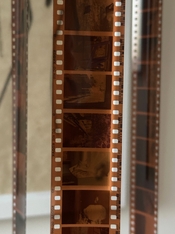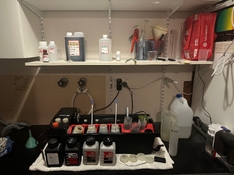benderscameracorner
Member
Hi all,
After much planning, procrastination and acquisition of kit, I finally dipped my toe into C41 development over the weekend. And by "dipped", I mean I blasted through the 12-roll backlog of undeveloped rolls that have been sitting in my fridge for far too long. To my genuine surprise, it all seems to have gone well. There's some pretty dark brown strips from various 20+ year expired rolls of NPH400 and Porta 400NC, as to be expected, but the fresh stuff looks good and everything has images on it. Proof will be in the scanning when I get to that, but it appears there's been no major failures in the development itself.
My question relates cross contamination of chemicals, particularly of the bleach into the fixer and stabiliser. I'm using the Ilford Ilfocolor C41 kit, which (along with the ECN2 and E6 kits) are about the only reliably available chemicals here in Australia currently, though weirdly they don't seem to be talked about much elsewhere in the world ie. few reviews/videos on it. Apparently they're the same as the Jobo C41 chems and rumour has it both are based on the well known/loved Fuji Hunt 5L kits... though whether that's just because both originate from Japan and the bottles look kinda similar, I'm not sure.
Anyhoo, the instructions from Ilford (which can be found here, btw https://ilfocolor.com/wp-content/uploads/2024/06/ILFORD-ILFOCOLOR_TDS_C41_english_11_23_v3.pdf - for some reason they don't include in them in the kit itself, thankfully my local retailer emailed them through) state a 5:00 min water prewash/prewarm, then colour dev, then bleach, then fix, then a 1:00min wash, then stabiliser.
I dutifully did as directed and on the first roll saw my fixer turn a lovely shade of pink/evil blackcurrent cordial. A quick search here and elsewhere revealed that a water wash after the bleach is typical/recommended for most kits (makes sense) to keep as much bleach out of the subsequent steps and protect the fixer. I added two washes of 38*C water after bleach in the subsequent processing runs, which seemed to work well, though obviously the damage was done for this batch of chemicals.
Fortunately I only mixed up a third of a kit (a little over 800mL working solution, using about 600mL to comfortably fill a fully loaded 1540 drum with 3-4 rolls) to cover the film I had ready to go with minimal waste (Ilford reckon the 2.5L is good for 40 rolls), so they're spent and will be disposed off shortly.
I am a bit curious/concerned though about future batches though, as I'll want to extend the life of the working solutions as much as possible. This old thread https://www.photrio.com/forum/threads/rinse-steps-in-c-41-development.199420/ seems to hint at both washing stages after dev AND bleach being desirable/necessary for rotary/inversion processing where you're not one-shot-ing chems. Getting as much usable life is obviously desirable... the kits aren't cheap and for 35mm at least my local lab is quite economical for dev only. It's unlikely I'll be in a position to bash through so many rolls in 24 hours again, so while I'm fully aware colour developer especially isn't very long lived, I'm hoping to get a couple of weeks, maybe more, with careful storage and keeping each stage as clean as possible.
I guess my real question is: what's a realistic best practice for home C41 development, to get the most value out of your typical chemical kit without unduly risking subpar results?
As an aside and a complete noob question: is substantial darkening of the developer typical after each batch? After a dozen rolls it was approaching the darkness of the bleach. The 5:00 min prewash revealed all manner of colouration when dumped, so I'm a little surprised... I've always prewashed my black and white film to preserve the dev (Microphen currently) for reuse, a little darkening over the 10 roll-lifespan is typical, but nothing like this. Just a C41 thing?
Cheers, Ben.
After much planning, procrastination and acquisition of kit, I finally dipped my toe into C41 development over the weekend. And by "dipped", I mean I blasted through the 12-roll backlog of undeveloped rolls that have been sitting in my fridge for far too long. To my genuine surprise, it all seems to have gone well. There's some pretty dark brown strips from various 20+ year expired rolls of NPH400 and Porta 400NC, as to be expected, but the fresh stuff looks good and everything has images on it. Proof will be in the scanning when I get to that, but it appears there's been no major failures in the development itself.
My question relates cross contamination of chemicals, particularly of the bleach into the fixer and stabiliser. I'm using the Ilford Ilfocolor C41 kit, which (along with the ECN2 and E6 kits) are about the only reliably available chemicals here in Australia currently, though weirdly they don't seem to be talked about much elsewhere in the world ie. few reviews/videos on it. Apparently they're the same as the Jobo C41 chems and rumour has it both are based on the well known/loved Fuji Hunt 5L kits... though whether that's just because both originate from Japan and the bottles look kinda similar, I'm not sure.
Anyhoo, the instructions from Ilford (which can be found here, btw https://ilfocolor.com/wp-content/uploads/2024/06/ILFORD-ILFOCOLOR_TDS_C41_english_11_23_v3.pdf - for some reason they don't include in them in the kit itself, thankfully my local retailer emailed them through) state a 5:00 min water prewash/prewarm, then colour dev, then bleach, then fix, then a 1:00min wash, then stabiliser.
I dutifully did as directed and on the first roll saw my fixer turn a lovely shade of pink/evil blackcurrent cordial. A quick search here and elsewhere revealed that a water wash after the bleach is typical/recommended for most kits (makes sense) to keep as much bleach out of the subsequent steps and protect the fixer. I added two washes of 38*C water after bleach in the subsequent processing runs, which seemed to work well, though obviously the damage was done for this batch of chemicals.
Fortunately I only mixed up a third of a kit (a little over 800mL working solution, using about 600mL to comfortably fill a fully loaded 1540 drum with 3-4 rolls) to cover the film I had ready to go with minimal waste (Ilford reckon the 2.5L is good for 40 rolls), so they're spent and will be disposed off shortly.
I am a bit curious/concerned though about future batches though, as I'll want to extend the life of the working solutions as much as possible. This old thread https://www.photrio.com/forum/threads/rinse-steps-in-c-41-development.199420/ seems to hint at both washing stages after dev AND bleach being desirable/necessary for rotary/inversion processing where you're not one-shot-ing chems. Getting as much usable life is obviously desirable... the kits aren't cheap and for 35mm at least my local lab is quite economical for dev only. It's unlikely I'll be in a position to bash through so many rolls in 24 hours again, so while I'm fully aware colour developer especially isn't very long lived, I'm hoping to get a couple of weeks, maybe more, with careful storage and keeping each stage as clean as possible.
I guess my real question is: what's a realistic best practice for home C41 development, to get the most value out of your typical chemical kit without unduly risking subpar results?
As an aside and a complete noob question: is substantial darkening of the developer typical after each batch? After a dozen rolls it was approaching the darkness of the bleach. The 5:00 min prewash revealed all manner of colouration when dumped, so I'm a little surprised... I've always prewashed my black and white film to preserve the dev (Microphen currently) for reuse, a little darkening over the 10 roll-lifespan is typical, but nothing like this. Just a C41 thing?
Cheers, Ben.






 It's actually my laundry but the ratio of darkroom gear to laundry stuff is about 2:1 ;-) Works OK but I'm hoping the next house will get a dedicated darkroom in due course.
It's actually my laundry but the ratio of darkroom gear to laundry stuff is about 2:1 ;-) Works OK but I'm hoping the next house will get a dedicated darkroom in due course. 

